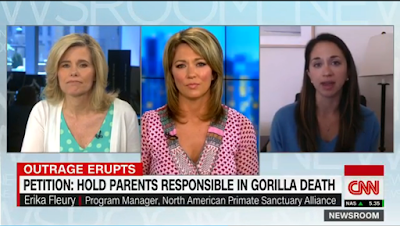Well, I did it…. The last few months have been a bit of a whirlwind leading up to this event. As NAPSA's Program Manager, I am responsible for organizing its semi-annual conference, the
NAPSA Workshop. NAPSA's last Workshop was held in 2014, right before I was hired, and in 2015 I developed an online Virtual Workshop. Putting together an in-person Workshop was a whole new animal for me.
Although I worried about every possible thing that could have gone wrong, the vast majority of those things did not, actually, go wrong, and
NAPSA Workshop 2016 was very successful! We ended up having over 80 attendees join us for two days in Tacoma, Washington, and then a smaller group was able to tour NAPSA member Chimpanzee Sanctuary Northwest in nearby Cle Elum, Washington on the third day. The event ran from September 22nd - 24th.
 |
One of the tour groups of Chimpanzee Sanctuary Northwest
|
As the host of the Workshop, I was in front of the microphone constantly for two days, and monitoring the time of every segment of every panel to ensure that our guests all got their allotted time for speaking. It was exhausting and wonderful, but most of all I was honored to be amongst such a powerful, intelligent, and dedicated group.
 |
| Full house! |
NAPSA was pleased to host guest speakers with myriad of expertise and points of view. I was grateful to have the following organizations represented on our stage:
- Center for Great Apes
- Chimp Haven
- Chimpanzee Sanctuary Northwest
- Chimps Inc
- Cleveland Amory Black Beauty Ranch
- Fauna Foundation
- Foray Consulting
- Global Federation of Animal Sanctuaries
- Humane Society of the United States
- International Primate Protection League
- Jungle Friends Primate Sanctuary
- Lincoln Park Zoo
- Pan African Sanctuary Alliance
- Primate Rescue Center
- Project Chimps
- Stanford University
- University of Washington
- Wildlife Waystation.
 |
| NAPSA's Steering Committee |
I think one of the most thrilling moments of the Workshop was when it was recognized that the actions of the people in that room were ending many of the uses of primates in captivity, and literally changing history in terms of human culture and animal welfare. Reading the data on how very few chimps are used in entertainment, for example, compared to that same statistic from just 15 years ago, brought chills to me. That same energy that successfully delivered captive chimpanzees to sanctuaries throughout the country is now being applied to monkeys being exploited in the same ways - in labs, in entertainment, and in the pet trade - and although it is a large hill to climb, progress is already being made. That's what NAPSA's Workshop is all about - joining forces to celebrate what has been accomplished and focus on what remains to be done... and it will be done.
 |
| Doing what I do. |
 Exciting news - I was asked to co-author a book chapter with Wesleyan University professor, philosopher, ethicist and well-published author Lori Gruen. The book, titled Nonhuman Primate Welfare, is expected to be the most extensive of its kind.
Exciting news - I was asked to co-author a book chapter with Wesleyan University professor, philosopher, ethicist and well-published author Lori Gruen. The book, titled Nonhuman Primate Welfare, is expected to be the most extensive of its kind.














